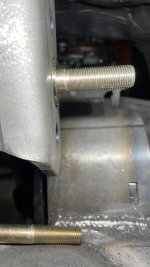I wouldn't be cutting fresh threads into fasteners. As far as the stack up goes, you only 'need' full shoulder diameter to the interface of the joint and the bracket - that's your shear plane.
1/4" weld washer + 1/4" bracket + 2-5/8 joint = 3-1/8" shoulder length minimum. Add another 1/4" for your nut side bracket plate and another 1/4" for your other weld washer and your absolute max shoulder length would be 3-5/8".
Looks like a 5" bolt will put you right at your 3-5/8" shoulder length. If you find that's a touch too long to get a nut on it, add a hardened washer.

Alternatively, a 4.5" bolt will give you right at the calculated minimum shoulder length and would ensure 100% that you would be able to get a nut on it without cutting threads or adding another washer. Decisions decisions.
This is my go-to torque chart. My machine design book says 'when in doubt, assume K = .20 for dry threads.' (paraphrased). I assume you have at least 9/16" link bolts, which will run you up to around 150ft lbs for a Grade 8 fastener.
Fastenal Master Torque Chart



